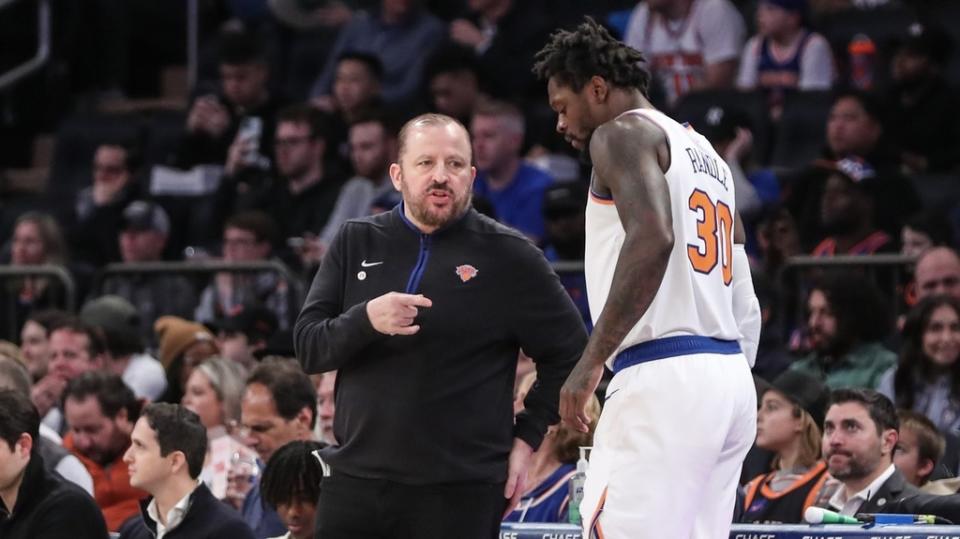Breaking down Tom Thibodeau's third season as Knicks head coach, including what improvements must be made

There aren’t many coaches who inject their personality into a team’s identity quite like Tom Thibodeau.
If one thing has stood out about the Knicks’ surprising 2022-23 season, it was how, under Thibodeau, they would constantly grind with an imperfect offense and a sometimes inflexible defense, win or loss.
Following the Knicks’ second-round exit at the hands of the Miami Heat, there are still questions about the Knicks and their coach after the team’s most successful season in 10 years.
When compared to other coaches in the franchise’s recent past, Thibodeau looks like a Hall of Famer. In three seasons, he’s coached the club to a 125-111 record (53 percent win percentage) and won one playoff series.
After a disappointing 2021-22 season that saw the Knicks miss the playoffs, and a shaky start to this season, Thibodeau’s seat simmered. Despite the increased pressure, he made some key rotation decisions that worked.
In the first seven games, incumbent starter at shooting guard Evan Fournier was benched in favor of a combination of Quentin Grimes and Cam Reddish.
Fournier would play just six more games in the rotation before his permanent banishment to the bench outside of some spot appearances due to injury.
In early December, the team was 10-13 after a jarring 121-100 blowout loss against the Dallas Mavericks. It was after that game that Thibodeau benched veteran Derrick Rose and Reddish, while adding Miles McBride into the rotation. After the decision, the Knicks won their next eight games and went 37-22 over the final 59 games, saving the season.
By the trade deadline, the team added Josh Hart from the Portland Trail Blazers. The move added the perfect hard-nosed fit for Thibodeau’s coaching style and helped cement the Knicks as a legitimate playoff contender.
Thibodeau’s performance in the playoffs had some good moments. In the team’s first-round 4-1 series win against the Cleveland Cavaliers, he made the decision to have guards and wings like RJ Barrett be the screener rather than big men such as Mitchell Robinson and Julius Randle, which helped relieve the immense amount of pressure Jalen Brunson was facing.
New York also did a good job of containing Cleveland’s two star guards Donovan Mitchell and Darius Garland. The Cavaliers were last among all playoff teams in offensive efficiency, scoring just 101.9 points per 100 possessions.

Lacking flexibility
Though those decisions were correct in the Cleveland series, in retrospect, they were not painfully difficult to make. The Cavaliers played two traditional big men in Jarrett Allen and Evan Mobley, incapable of making the Knicks pay from the perimeter, and they also had limited options in finding a quality small forward who could knock down open shots while being able to guard Brunson.
That was exposed in the second-round series with the Heat, who have an offense with more flow and ball movement.
Miami was also prepared to play different defensive styles, including zone, and often loaded up in the paint and dared the Knicks to shoot, and New York was unable to make them pay as they shot just 29.9 percent on 211 three-point attempts.
To be fair, the Knicks struggles against the Heat weren’t an anomaly. New York shot 42-of-149 from the three-point line (28.2 percent) in the first round, which was the worst mark among all playoff teams.
Though New York’s identity of mashing up the opposition with isolations and offensive rebounds propelled them to a rank of third in offensive efficiency during the regular season, it was always going to be less effective in the postseason against stouter competition.
Going small
Thibodeau had no adjustment for that. He rarely went small in any situations.
Power forwards Randle and Obi Toppin are not great three-point shooters but they at least are somewhat of a threat from outside. The duo played just seven minutes together in the postseason. Over three regular seasons, Thibodeau has played them together for just 212 combined minutes.
The Knicks also passed up lineups playing Brunson, Randle and three wings for much of the season.
New York is a better defensive team when they have a traditional center like Robinson or Isaiah Hartenstein capable of protecting the rim and rebounding, but it also ties an anchor to the offense due to a lack of spacing.
When you add in the spotty outside shooting of Hart and Barrett, you have the Heat series where it felt like Brunson was going 1-on-5 at times.
If the Knicks hope to ascend even further, the front office will need to retool the team’s personnel to add more shooting, but Thibodeau also has to embrace trying new lineups in the regular season to prepare for playoff adjustments.
Is Thibodeau the man to take this Knicks roster even further? It’s hard to tell. It’s clear he has elevated the floor of the team from years past, and is more willing to make some rotation changes, but he hasn’t been able to evolve the offense.

